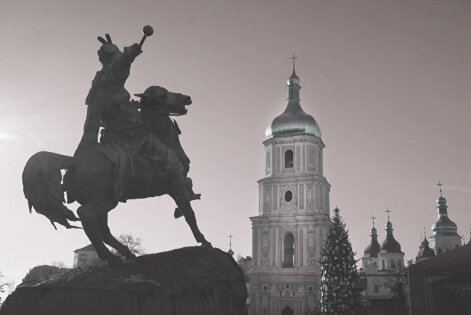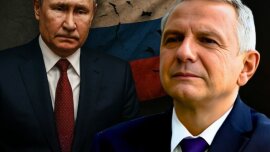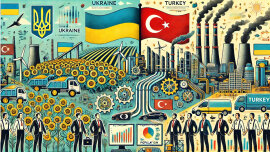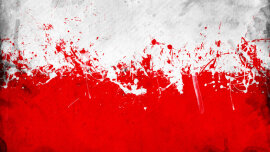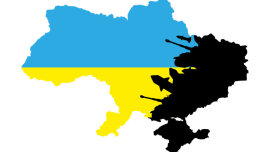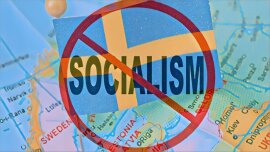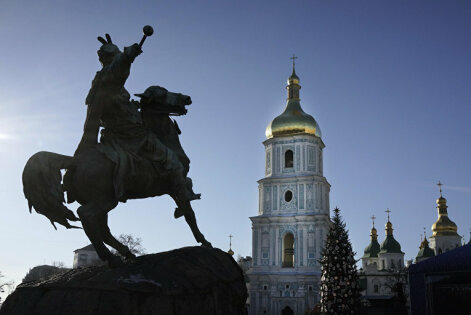
In his article “On the Historical Unity of Russians and Ukrainians,” Vladimir Putin completely missed the historical origin of Russians, whose ethnic roots go back to Poland from those who came in the 8th century. to the European territory of the modern Russian Federation of the first Slavic tribes Krivichi (Pskov-Smolensk), Slovenia (Novgorod land) and Vyatichi (the region of the Moskva River and further south), as well as the local large Finno-Ugric population (Merya, Moksha, Chud, Ves’, Izhora etc.).
Ukrainians are the grandchildren of the first Slavs – the Ants and Sklavins, who had their statehood already in the 4th century AD (the union of the tribes of the Antes), as well as the direct descendants of the Rus, who, in the same territory after the existence of the Kyiv state (482-882), created a new Slavic state Rus (882) with the center in the same Kyiv, that was mentioned by Andrew the First-Called, staying on the Dnieper hills in 1st century AD, as “a magnificent city, clothed with God’s grace, to be built on this site.”
Considering that some of the historians of the Moscow-Petersburg school constantly tried to gradually extend the idea that Ukrainians in the Dnieper region appeared only after the Mongol-Tatars had destroyed the state of Rus, as if replacing the local population after the Tatar defeat, which, in principle, is also voiced by the head of the Kremlin in his article, we shall analyze some aspects of this historical period.
After the capture of Kyiv in 1240 by the Mongol-Tatars and its burning, the state of Rus with its center in Kyiv (882-1240) practically stopped to exist. In this regard, for one century the center of statehood of the Rus moves to raising its power Galicia-Volyn principality becoming the Russian kingdom after the coronation of the Grand Prince Danil of Galicia by the Pope. However, the lands on which the Rus lived gradually began to fall under the possession of the Lithuanians, with whom they remained in a single state – the Grand Duchy of Lithuania, Zhemait and Rus, where the language of the Rus was the official language along with Lithuanian, and the Rus took an active part in governing the country.
At this time, the territories where the Russians lived (the Pskov and Novgorod lands, the Vladimir-Suzdal, Smolensk, Tver and Ryazan principalities) were in the possession of the Mongol-Tatar state – the Golden Horde. The princes of Vladimir, through bribery, achieved that the cathedra of the Kyiv Metropolitanate moved from Kyiv to the territory where the Russians lived – to Vladimir on the Klyazma (1299). The outraged Kyivites immediately turned to the Patriarch of Constantinople to get them a new Metropolitan of Kyiv. On the lands where the Russians lived, the newly formed Moscow principality began to dominate, which, having lured a label from the Golden Horde to collect taxes, secretly kept part of the money, thus enriching itself. In this regard, the chair of the metropolis was smoothly moving from Vladimir on the Klyazma to Moscow, where money and influence were located. With the creation of the Grand Duchy of Moscow, local princes use less and less the language of Kyiv, which was official in Russia, using more of the local dialects of the Vyatichi. In the years 1448-1589 the Moscow Metropolis was in schism and non-recognition by the canonical Orthodox churches. And when the Archbishop of Veliko-Novgorod and Pskov, the Orthodox clergy, died in 1470, the believers asked the Metropolitan of Kyiv, who had traditionally been the head of the church since its founding in 988, and had always been canonically recognized, so that he would highlight the new archbishop, then Moscow went to war against Novgorod in 1471.
Calling the annexation of territories to the Grand Duchy of Moscow “collecting lands”, the head of the Kremlin is silent about murders of Moscow’s competitors, blackmail of those who do not agree to join Moscow, bribery of all doubters. However, there is also historical accuracy in this statement, as Moscow began to collect lands ethnically close among themselves, which were inhabited mainly by Russians, who lived under the rule of the state of the Golden Horde. And the Russ, as the children of the Antes, remained in the Lithuanian, and later the Polish-Lithuanian state. The lands where the Rus lived were increasingly beginning to be called Ukraine. For the first time this name was mentioned in 1187. Accordingly, the name of the people gradually passes from the Rus to the Ukrainians. But it was a long process that lasted until the 19th century. For example, in the famous battle of 1514 near Orsha, the united Lithuanian-Russian army under the command of the Ukrainian hetman K. Ostrozhsky inflicted a crushing blow on the Muscovite army. And in 1654, when a military treaty was signed between the Zaporozhian Army, which had been waging a bloody war with the Poles for six years, and the Moscow state, the parties were the Russian Hetman B. Khmelnitsky and the Tsar of Moscow A. Romanov. People of the area of Moscow, Smolensk, Pskov, Novgorod had never been named Russians in the lands where the Rus lived. At first, they were called Muscovites, by the name of dominant Moscow, and from the 18th century – Russians. Russian is a self-name. The Balts always called them Krivichi, and the Poles with the Ukrainians firstly called them Muscovites, and layer Russians (by the name of the country since 1721 – Russia).
The head of the Kremlin, out of his own considerations, decided in the article to cite a letter from the Ukrainian hetman that allegedly B. Khmelnitsky “thanked Tsar Alexei Mikhailovich that the Orthodox people, Rus (in the Ukrainian text of the article on the Kremlin’s website, for some reason, they write generally” Russian “) arm in arm … he accepted the royal one. ” But you need to understand that the Treaty of Pereyaslavl in 1654 was not an act of reunification of Ukraine with Russia, as Moscow wants to present it. In the six-year war with the Poles, the hetman was looking for new allies, so he turned to the Kremlin to form a military alliance. Two years later, Bohdan Khmelnitsky already regretted that he had done this, since Moscow began to conduct separate negotiations with the Rzecz Pospolita on the division of spheres of influence in Ukraine. Considering this an act of betrayal, in 1656 the Zaporozhian Army severed relations with the Moscow state. Warsaw understood the difficulties of fighting the Ukrainian Cossacks and proposed to reorganize the country, where instead of the Polish-Lithuanian state, there would also be a third component – the Ukrainian one, proposing in 1658 to sign the Hadyach Union as the creation of a Polish-Lithuanian-Ukrainian state. The new hetman of the Zaporizhzhya Army, Ivan Vyhovsky, agreed to this, but the Polish Seim at the last moment began to make amendments to the agreement, thereby disrupting the signing act.
Moscow, feeling that the plan to unite the Ukrainians with the Poles had failed, with huge troops moved to Ukraine in 1659, but near Konotop suffers a crushing defeat from the Cossack-Crimean Tatar army. Fearing a subsequent attack on Moscow, Tsar A. Romanov began to prepare for the evacuation to the northeastern possessions. However, the secret activity of the embassy order of the Moscow state, which had long been engaged in bribery of the Cossack elite, in particular the Poltava colonel Zolotarenko, who opposed the attack on the territory of the Moscow state, worked here. He was also joined by the Cossacks of the Zaporozhye Sich, who considered the Moscow state a lesser evil than the Ottoman Empire. But if they knew that by their actions they did not allow the Hetman Ukraine to wriggle out of the iron embrace of Moscow, which a few years later signed treacherous for the Ukrainians the Andrusiv truce with the Poles in 1667, after which the Right Bank Ukraine remained with Poland, and the Left Bank together with Kyiv and territories of the Zaporizhzhya Sich withdrew to the Moscow state. Moscow and Warsaw did not have the strength to completely control Ukraine, so they decided to divide it among themselves.
After that, a catastrophic long-term period of Ruins begins in Ukraine, when Warsaw pushed the Right Bank Cossacks on military campaigns against the Left Bank Ukraine, and Moscow, on the contrary, provoked the Left Bank Cossacks to attack the Right Bank Ukraine. The Cossacks could not even think that in 100 years in 1775 Russia would destroy the Sich and seize the vast lands that the Cossacks owned, calling them Novorossia together with the conquered territories of the Crimean Khanate and the Edisan Horde (the territory of the modern Nikolaev and Odessa regions was under direct control of Turks), now claiming to be historically Russian lands! And if in 1618 the Zaporozhian Army, led by Hetman P. Sahaidachny, during a joint campaign with the Poles against the Moscow state with the aim of introducing the Polish prince to the royal throne, had captured Moscow, then the act of liquidating the Hetmanate in Ukraine in 1764 would never happen. Judge for yourself, squeezing the ring around Moscow, the Zaporozhye Cossacks, together with the Poles, broke into the outskirts of Moscow. Having captured part of the Arbat, the Polish troops and the Cossacks had to retreat from the captured positions, recognizing it unnecessary to complete the course of the battle at the expense of large human losses, considering the huge concessions from the Kremlin sufficient. And if Moscow had fallen, then the duration of the reign of the Romanov dynasty would not have been 304 years, but only five years, and the new tsar, the son of the Polish king Sigismund III, would have relied in his rule in Moscow not only on the Polish army, but also on the Zaporozhye Cossacks. In this way, Moscow was already conquered by False Dmitry I back in 1605.
False Dmitry II also had great prospects, who also had the support of the Zaporozhye Cossacks and the Ukrainian population of Chernigov, Novgorod-Severshchina and Starodubshchina. It was there, with the help of the Ukrainians, that False Dmitry II defeated the three times superior army of Muscovites led by the boyar V. Shuisky in 1608. However, he was killed by the conspirators in 1610. A new chance to put the representative of Warsaw on the Moscow throne at the end of 1618 was a bit short. If Tsarevich Vladislav and Hetman P. Sahaidachny assumed that Moscow would destroy the Polish and Ukrainian statehood in 150 years, they would probably have made sacrifices, but completed the capture of Moscow, once and for all, solving many problems for the Ukrainians and Poles in the next four centuries. And so, from that historic trip to Moscow, we have only a song left “Hey, in the valley, hey, the Cossacks are coming!”.
